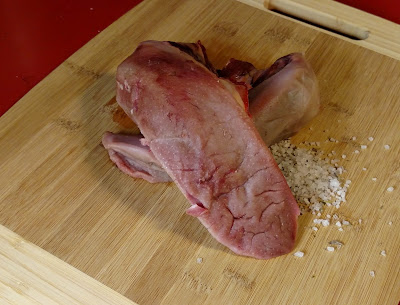Pork Tongue with Lentils and Salsa Verde
When I first became serious about cooking offal, I had great success with tongue right off the bat. Because tongue is very similar to skeletal muscle cuts, the process of cooking tongue was actually quite familiar. Like brisket or eye of round, tongue has a similarly dense texture with long striations, making it easy to braise and then slice against the grain, and is wonderfully rich and savory. Tongue also contains a good amount of collagen, which gives it a lip-smacking quality like oxtail or pork hocks.
 Once the tongues are cooked, they’re almost ready to eat. The only special treatment a tongue requires in the kitchen is to peel off the thick, leathery membrane. It’s not as tricky as it might seem--cooking turns the outer membrane of the tongue an opaque white, making it easy to identify where the membrane ends and the meat begins. It’s best to peel the tongues while they’re still warm. Just begin at one edge and peel like an orange; the membrane will come off in strips. Occasionally a section might be “stuck” to the meat, but these bits of membrane can just be nicked off with the tip of a sharp knife.
Once the tongues are cooked, they’re almost ready to eat. The only special treatment a tongue requires in the kitchen is to peel off the thick, leathery membrane. It’s not as tricky as it might seem--cooking turns the outer membrane of the tongue an opaque white, making it easy to identify where the membrane ends and the meat begins. It’s best to peel the tongues while they’re still warm. Just begin at one edge and peel like an orange; the membrane will come off in strips. Occasionally a section might be “stuck” to the meat, but these bits of membrane can just be nicked off with the tip of a sharp knife.
 While working on the tongue, I find it’s a good time to get a side dish cooking. A quick dish of earthy lentils pairs perfectly with the full flavor of the tongue. I reuse the tongue’s cooking liquid by bringing it back to a boil, adding in my lentils, and simmering them until tender.
While working on the tongue, I find it’s a good time to get a side dish cooking. A quick dish of earthy lentils pairs perfectly with the full flavor of the tongue. I reuse the tongue’s cooking liquid by bringing it back to a boil, adding in my lentils, and simmering them until tender.
 |
| Berkshire Pork Tongues |
I especially like cooking pork tongues, as their 6-8 oz size makes it easy to portion one per person. For this recipe I used two pork tongues from North Woods Ranch Berkshire hogs. To start, tenderize the tongues by gently simmering them on the stove top for two hours cooking. I seasoned the tongues with sea salt and put them in a small pot with pork stock, a bay leaf, and a small bundle of thyme. To check doneness, a knife should easily slide into the tongue without any resistance.
 |
| Tongues After Cooking: Notice the membrane is distinctly white |
 Once the tongues are cooked, they’re almost ready to eat. The only special treatment a tongue requires in the kitchen is to peel off the thick, leathery membrane. It’s not as tricky as it might seem--cooking turns the outer membrane of the tongue an opaque white, making it easy to identify where the membrane ends and the meat begins. It’s best to peel the tongues while they’re still warm. Just begin at one edge and peel like an orange; the membrane will come off in strips. Occasionally a section might be “stuck” to the meat, but these bits of membrane can just be nicked off with the tip of a sharp knife.
Once the tongues are cooked, they’re almost ready to eat. The only special treatment a tongue requires in the kitchen is to peel off the thick, leathery membrane. It’s not as tricky as it might seem--cooking turns the outer membrane of the tongue an opaque white, making it easy to identify where the membrane ends and the meat begins. It’s best to peel the tongues while they’re still warm. Just begin at one edge and peel like an orange; the membrane will come off in strips. Occasionally a section might be “stuck” to the meat, but these bits of membrane can just be nicked off with the tip of a sharp knife. While working on the tongue, I find it’s a good time to get a side dish cooking. A quick dish of earthy lentils pairs perfectly with the full flavor of the tongue. I reuse the tongue’s cooking liquid by bringing it back to a boil, adding in my lentils, and simmering them until tender.
While working on the tongue, I find it’s a good time to get a side dish cooking. A quick dish of earthy lentils pairs perfectly with the full flavor of the tongue. I reuse the tongue’s cooking liquid by bringing it back to a boil, adding in my lentils, and simmering them until tender.To serve the tongue slice it horizontally from tip to base, cutting against the grain of the meat to produce tender slices. The base may have some fatty sections, which can be trimmed off if desired.
With the rich meat of the tongue and the earthly lentils, I brighten up the flavors by finishing off the dish with something like an Italian salsa verde, which is simply parsley, rosemary, garlic, capers and olive oil. Pureed together, the sauce should be a little looser than a pesto, since there are no nuts or cheese in salsa verde to thicken it. With a fresh herbal flavor and a piquant note from the garlic and capers, it’s perfect for spooning over the tongue, or almost any braised meat.
Recipe at a Glance
- 2 pork tongues
- 1 pint of pork or vegetable stock
- 1 fresh bay leaf
- 1 cup of dried black lentils
- 1/2 bunch of parsley (about 1 cup, roughly chopped)
- 4 oz olive oil
- 2 cloves garlic, crushed
- 1 sprig rosemary, leaves removed from stem
- 2 tsp capers (rinsed)
- Salt and pepper to taste (capers will add some salt)
Bring the stock to a boil in a small pot. Add the tongues, bay leaf, and a bit of sea salt (more if your stock is unsalted) to the pot. Reduce to a simmer and cook at a gentle simmer on the stove top, or braise in the oven at 325 F. Tongues should be done after two hours, or give another 20 minutes or so until tender.
Remove the tongues from the liquid and allow to cool slightly on a plate. Bring the braising liquid back to a boil and add the lentils, then cover the pot and lower heat to a simmer. Depending on the type of lentils, they'll be tender in 15-20 minutes. Taste one at the 15 minute mark, adding more liquid if necessary to keep lentils covered. When cooked, adjust seasoning and discard bay leaf.
To make the salsa verde, puree the parsley, olive oil, garlic, capers, and rosemary leaves in a blender until smooth. Taste and adjust the salt if necessary.
When the tongues are cool enough to handle, but still warm, peel off the outer membrane, starting from the underside and pulling up to the top of the tongue. Remove any "stuck" sections of membrane with a knife.
To serve, lay down a bed of lentils, then a spoonful of salsa verde. Slice the tongue against the grain and place on the salsa verde. Sprinkle with more sea salt and pepper.



Comments
Post a Comment